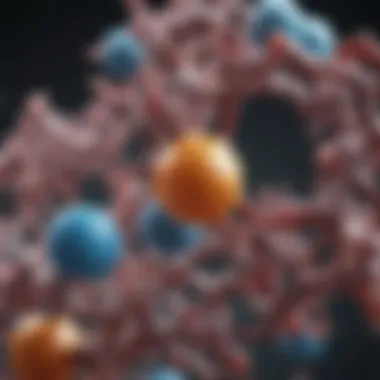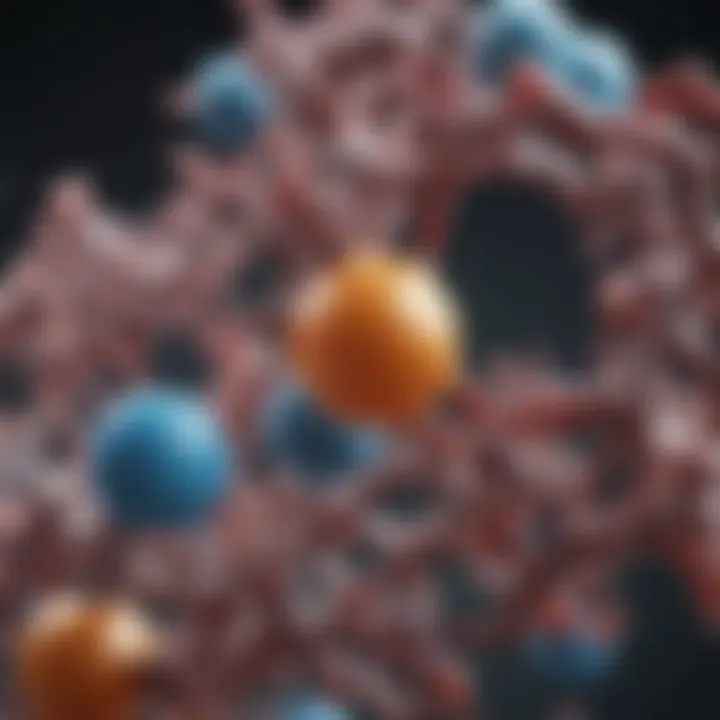Exploring the Impact of Epidermal Growth Factor


Overview of Research Topic
Epidermal Growth Factor (EGF) plays an important role in cell biology. Understanding what EGF is and how it operates is fundamental for those delving into modern science. In the realm of cellular growth and healing processes, EGF acts as a key player. It influences how cells communicate, grow, and differentiate, making it significant in various biological and medical fields.
Brief Background and Context
EGF was first discovered in the early 1960s, when it was found in the saliva of mice. This initial finding unveiled its potential in stimulating cell growth and division. Over the years, EGF has been the subject of numerous studies that have confirmed its vital function in wound healing, tissue repair, and even in the development of certain cancers. Its discovery opened new avenues for research into its applications—ranging from regenerative medicine to oncology.
Importance in Current Scientific Landscape
Today, EGF is more than just a protein; it embodies hope in many medical advancements. From enhancing skin care products to improving surgical recovery times, the implications are broad and profound. With the surge in interest for targeted therapies, EGF remains a focal point of research. This growing focus underscores the necessity for further inquiry into its mechanisms and applications.
Methodology
In the study of EGF, researchers employ various methodologies to unpack its complex functionalities. Understanding how to approach this intricate protein allows scientists to derive more applicable theories and practical outcomes across different fields.
Research Design and Approach
Most research involving EGF starts with in vitro experiments, where cell cultures are used to examine the direct effects of EGF. This allows for controlled conditions ideal for studying cell signaling pathways and various cellular responses. In vivo methods follow, providing insights into how EGF interacts with whole organisms, revealing its systemic effects.
Data Collection Techniques
Data collection concerning EGF typically involves a combination of observational and experimental techniques. Researchers may utilize advanced imaging technologies to monitor cellular changes and enzyme assays to quantify biological responses. Additionally, bioinformatics tools often analyze large datasets to explore EGF's role in disease pathology and therapeutic interventions.
In recent years, understanding EGF's signaling network has become essential for advancing therapies in regenerative medicine and cancer treatments.
This systematic approach in studying EGF allows for a richer understanding and highlights its pivotal role in scientific exploration, setting the stage for future innovations.
Prolusion to Epidermal Growth Factor
Epidermal Growth Factor, commonly referred to as EGF, plays a vital role in cellular processes that are fundamental to growth, healing, and development. This protein has carved its niche in modern science, particularly within areas of cellular biology, regenerative medicine, and oncology. Understanding EGF’s functions and applications helps to elucidate the significant impact it has on various biological processes and clinical innovations.
One of EGF’s key benefits lies in its ability to stimulate cell proliferation and differentiation, a capability that is not just a neat trick in the lab but has practical applications in medicine and therapeutic contexts. For instance, in wound healing, the role of EGF in initiating and regulating cellular responses means it can aid in the regeneration of tissues. Researchers are keenly examining how to harness this ability effectively, making it a hotbed of study in both experimental and clinical settings.
Additionally, the implications of EGF extend into the realm of cancer treatment, where its pathways can either contribute to tumor growth or present targets for innovative therapies. As we peel back the layers surrounding EGF, we’ll not only uncover its mechanism of action but also highlight the ethical considerations and regulatory frameworks that shape research and application in this area.
As we delve deeper into this topic, the complexity and multifaceted nature of EGF will be apparent—reflecting its profound significance in modern biological and medical science.
Defining Epidermal Growth Factor
Epidermal Growth Factor is a single-chain polypeptide that plays a pivotal role in the regulation of cell growth and reproduction. It was one of the first growth factors to be discovered, and its function centers around binding to the EGF receptor, which initiates a cascade of biochemical events necessary for cell division and survival. This makes it a key player in various physiological processes, including embryonic development, tissue repair, and maintenance of epithelial tissue integrity.
In essence, EGF acts like a conductor of a symphony, orchestrating various cellular functions to create a harmonious environment for growth and healing. Its presence in the body is critical; without sufficient levels of EGF, cellular functions can be disrupted, leading to a variety of health concerns. Therefore, an in-depth understanding of EGF is not only essential for biologists but also for clinicians aiming to leverage its properties in therapeutic settings.
Discovery and Historical Context
The saga of EGF began in the early 1960s when it was isolated by researchers, including the influential scientist Stanley Cohen. Cohen’s work at Vanderbilt University opened new avenues in biochemistry, providing insights into how proteins can influence cell behavior. The discovery marked a pivotal moment in biomedical research, demonstrating the potential of growth factors in developmental biology.
As research unfolded, it became clear that EGF was not an isolated phenomenon but rather part of a larger family of growth factors that regulate myriad biological functions. This period of exploration led to a surge in investigations around various growth factors, paving the way for drugs that target these proteins in conditions such as cancer and chronic wounds.
Today, EGF's importance is recognized not only in cellular biology but also in clinical applications. Its historical context highlights the flow of scientific inquiry that has shaped current understanding, making it a fundamental focus of ongoing research in the quest for novel therapies and improved medical outcomes.
Molecular Structure of EGF
Understanding the molecular structure of Epidermal Growth Factor (EGF) is pivotal for appreciating its role in various biological functions. The arrangement of atoms and the spatial configuration of EGF directly influence its interaction with cell receptors and subsequent signaling pathways. Without delving into structural intricacies, one cannot fully grasp how EGF operates at a cellular level; it's like trying to understand the engine of a car without looking under the hood.
Protein Composition
EGF is primarily known as a polypeptide comprising about 53 amino acids. Its sequence is key, as even a slight alteration in these amino acids can lead to drastic changes in functionality. For instance, the presence of specific residues allows EGF to bind efficiently to its receptor, the Epidermal Growth Factor Receptor (EGFR).
What makes the composition even more fascinating is that EGF includes a set of conserved stretches that foster crucial biochemical interactions. The arrangement of these amino acids contributes to EGF's fold, which is generally characterized by three loops stabilized by disulfide bonds. Each loop not only aids in the structural integrity but also enhances the protein's bioactivity. Consider it like a well-tuned instrument; without the right notes played in harmony, it simply won't sound right.
In summary, EGF's composition is integral to its function—any mutations or misfoldings can have significant pathological consequences. This holds true especially in the context of diseases where EGF signaling remains deregulated.
Conformational Dynamics
The conformation of EGF is not static; it undergoes dynamic changes that are crucial for its interaction with EGFR. The protein displays what you might call a dance of sorts, transitioning between various shapes depending on environmental cues and binding interactions. Specifically, in its native state, EGF exists in a compact form, which opens up upon receptor binding.
The importance of these conformational dynamics cannot be overstated. When EGF binds to EGFR, there’s an immediate structural shift in both proteins that activates complex signaling pathways within cells. This activation is akin to flipping a light switch—once the connection is made, a cascade of reactions is unleashed, leading to processes like cellular growth and differentiation.
Additionally, the conformational plasticity also suggests that EGF can adapt to other molecules. This versatility means EGF is ripe for further research, particularly in understanding how other drugs or compounds might influence its behavior.


"The structure of EGF is not merely an ensemble of atoms; it's an intricate symphony leading to cellular responses in the body.”
It’s worthwhile to note that the finer details of EGF's structure haven't been fully explored yet. This area of research holds promise, as understanding these dynamics might lead to novel therapeutic strategies for conditions where EGF plays a detrimental role, such as in cancer progression or inflammatory diseases. The interplay of structure and function continues to be a fertile ground for investigation.
Biological Mechanisms of EGF
Understanding the biological mechanisms of Epidermal Growth Factor (EGF) is crucial for comprehending its multifunctional roles in modern science. This aspect delves into how EGF orchestrates a variety of physiological responses, influencing cell behavior at different stages of development, healing, and disease processes. It lays the groundwork for further exploration into therapeutic avenues, particularly in regenerative medicine and oncology.
Signaling Pathways
EGFR Activation
The epidermal growth factor receptor (EGFR) serves as the primary conduit through which EGF exerts its effects. Upon binding to EGF, EGFR undergoes a conformational change that activates its intrinsic kinase activity. This activation is a pivotal step, as it initiates a cascade of intracellular signaling pathways, effectively acting as a switch that turns on various cellular processes.
One notable feature of EGFR activation is its specificity in function. This specificity is essential because it dictates how cells will respond to external stimuli, which can vary significantly depending on the environment and context. The benefits of this specific activation include the ability to fine-tune cellular responses necessary for tasks such as wound healing and tissue repair.
However, the activation of EGFR is not without its downsides. When unchecked, the signaling through EGFR can lead to excessive cell proliferation, a hallmark of many cancers. Therefore, while EGFR activation is a valuable mechanism in beneficial contexts, it also poses challenges in its regulation.
Downstream Effectors
Once EGFR is activated, it recruits a plethora of downstream effectors that propagate the signaling cascade. These effectors, including Ras and PI3K, are instrumental in mediating the cell's response to EGF. Essentially, they translate the signal from EGFR into actionable cellular responses, such as growth and survival.
A defining characteristic of these downstream effectors is their ability to enhance the complexity of the signaling pathways. This complexity enriches the network of responses that can occur within the cell, providing a versatile approach to manage various biological processes. This aspect makes the pathway indispensable for both normal cellular function and the pathology of diseases, such as cancer.
Nonetheless, one must consider that this high-level complexity can sometimes be a double-edged sword. The intricate interplay of these signals can lead to ontogeny missteps, where normal processes like apoptosis (cell death) might be disrupted, allowing aberrant cell growth instead.
Cellular Responses
Cell Proliferation
Cell proliferation, a critical response driven by EGF signaling, is fundamental in both normal tissue maintenance and injury responses. Under the influence of EGF, cells are prompted to progress through the cell cycle, thereby multiplying to replace lost or damaged cells.
A key feature of this process is its adaptability. The ability for cells to proliferate in response to specific signals is vital, particularly in scenarios like wound healing, where rapid cell turnover is necessary. This adaptability is also why modulation of EGF-related pathways is a focal point in developing strategies for tissue engineering and regenerative therapies.
However, while cell proliferation aids healing, its dysregulation can contribute to tumorigenesis. The balance between physiological and neoplastic proliferation is a delicate dance that researchers continue to investigate, underlining the complexity surrounding EGF’s role.
Cell Differentiation
Cell differentiation is yet another essential outcome of EGF signaling. Differentiation refers to the process where cells develop into specialized forms with distinct functions, necessary for forming organized tissues and organs.
The remarkable aspect of EGF-driven differentiation is its capacity to influence stem cells and progenitor cells into specific lineages. This characteristic is particularly beneficial for applications in regenerative medicine; for example, guiding pluripotent stem cells toward specific tissues can enhance the effectiveness of cell-based therapies.
Yet, just like proliferation, unchecked differentiation can lead to sacrosanct issues. If differentiation pathways are pushed too far or not adequately regulated, it may result in ineffective repair or unwanted cell types emerging. Thus, achieving a balance remains a key focus of ongoing research.
Understanding these biological mechanisms not only illuminates the fundamental roles of EGF in biology but also paves the way for targeted therapies that can leverage EGF for enhanced clinical outcomes.
EGF in Wound Healing and Tissue Regeneration
Epidermal Growth Factor (EGF) plays a pivotal role in wound healing and tissue regeneration, impacting a wide range of biological processes. With the ability to stimulate cellular proliferation and migration, EGF facilitates rapid repair mechanisms, making it a key player in the field of regenerative medicine. This section will explore both its fundamental contributions to injury repair and its diverse applications in enhancing skin regeneration.
Role in Injury Repair
EGF's involvement in injury repair is tantamount to its very definition; it promotes not only the crucial early phases of wound healing but also plays a significant role in the later stages of tissue remodeling. Following a wound, EGF is secreted by various cells, including platelets and macrophages, acting as a signal that triggers the healing cascade.
- Cell migration: When skin is injured, EGF encourages keratinocytes to migrate to the wound site. This movement is essential for covering the wound and can expedite the healing process.
- Cell proliferation: In addition to migration, EGF stimulates the division of fibroblasts, leading to collagen synthesis. Collagen is vital for skin strength and elasticity, providing a framework that supports tissue regeneration.
Despite its benefits, it's essential to consider that excessive EGF activity can lead to undesired effects, such as fibrosis or excessive scar tissue formation. A balanced approach to utilizing EGF in therapeutic settings ensures that its benefits are maximized while minimizing potential drawbacks.
Applications in Skin Regeneration
Topical Formulations
Topical formulations containing EGF have gained traction due to their straightforward application and noticeable benefits in skincare and dermatology. Products like creams and serums leverage EGF’s properties to enhance skin healing.
- Effectiveness: The key characteristic of topical EGF formulations lies in their ability to hydrate and promote skin barrier repair. Such formulations often show marked improvement in skin texture and reduced signs of aging.
- Unique features: A unique feature of these products is their capability to penetrate deeper layers of skin, providing targeted action. This function can result in improved radiance and elasticity, making them particularly popular among consumers looking for effective anti-aging solutions.
- Advantages and disadvantages: While the advantages include improved cosmetic appearance and enhanced healing, one must also consider the potential downsides, such as allergic reactions in sensitive individuals or the need for consistent application for optimal results.
Biomaterials Integration
The integration of EGF into biomaterials represents an innovative approach that transforms how we think about tissue repair. This strategy leverages the unique properties of EGF alongside materials such as hydrogels or scaffolds to encourage healing in a more structured environment.
- Key characteristics: One notable quality of these biomaterials is their ability to release EGF in a controlled manner, ensuring a steady supply of the growth factor where it's needed most. This sustained release can significantly improve tissue repair outcomes and minimize complications.
- Unique features: Many of these biomaterials are designed to be biodegradable, meaning they will naturally dissolve in the body post-application. This feature reduces the need for secondary surgeries to remove implants, a considerable benefit in clinical settings.
- Advantages and disadvantages: On the plus side, the synergy between biomaterials and EGF bolsters healing and can lead to enhanced aesthetic outcomes. However, as with any new approach, challenges include the potential for inflammatory responses or inadequate integration with host tissues.


The strategic use of EGF in wound healing has revolutionized advancements in regenerative medicine, reshaping how we treat injuries and skin conditions today.
In summary, EGF's role in wound healing and tissue regeneration is multifaceted and significant. Its applications, whether through topical formulations or biomaterials, offer promising pathways to enhance recovery and improve patient outcomes in the field of modern science.
Therapeutic Applications of EGF
Epidermal Growth Factor (EGF) has carved out a significant niche in modern medicine, particularly due to its therapeutic applications across various domains. Beyond its role in physiological processes, EGF is especially noted for impacting treatment avenues for serious conditions such as cancer and its contributions to regenerative medicine. The promise of EGF lies in its ability to stimulate cellular repair and growth, making it a focal point of study that extends its relevance in both clinical and research settings. As we dive deeper, we will explore specific applications that highlight the importance and versatility of EGF, particularly in cancer treatment and regenerative medicine.
Cancer Treatment
EGF Receptor Tyrosine Kinases
EGF receptor tyrosine kinases (EGFR) are a pivotal component when discussing EGF’s role in cancer therapies. A key characteristic of EGFR is its ability to facilitate the transmission of signals that drive cell proliferation and survival, primarily revolving around tumorigenesis. This aspect of EGFR is particularly beneficial because targeting these pathways can cripple cancer cells’ ability to grow unchecked.
The unique feature of EGF receptor tyrosine kinases is their dual role: they act as both receptors and activators of downstream signaling cascades. This means that if EGFR is activated inappropriately, it can lead to various cancers, making it a prime target for therapeutic intervention. However, the downside is that not all tumors respond uniformly to therapies aimed at inhibiting EGFR, which presents a challenge in defining a one-size-fits-all approach for treatment.
Targeted Therapies
Targeted therapies have become a buzzword in cancer treatment, owing much of their focus to the roles that EGF and its pathways play in cancer biology. The defining aspect of targeted therapies lies in their specificity — they aim to target specific molecules involved in tumor progression. This specificity can reduce collateral damage to normal cells, which stands in stark contrast to traditional chemotherapy.
A unique feature of these therapies is their adaptability, allowing them to evolve with the cancer itself. This tailored approach can lead to more effective outcomes and better management of side effects, a significant advantage in maintaining patients' quality of life during treatment. However, targeted therapies do have their setbacks, such as resistance to treatment emerging over time, necessitating continuous monitoring and, at times, a change in therapeutic strategies.
Use in Regenerative Medicine
Tissue Engineering
Tissue engineering employs EGF to accelerate healing and regeneration processes in damaged tissues. The field highlights a vital aspect: the ability to harness biological signals to guide the development of new tissues, thereby enhancing repair mechanisms in the body. EGF’s crucial role in stimulating cell growth makes it an essential candidate for incorporation in scaffolds and matrices designed for tissue repair.
One of its unique features is its ability to promote angiogenesis, or the formation of new blood vessels, which is necessary for tissue survival and function. This characteristic elevates EGF as a beneficial option for biomedical applications. However, optimizing the delivery of EGF in tissue engineering scenarios can be tricky, since correct dosing and timing are paramount to achieving the desired outcomes without overstimulation.
Stem Cell Therapy
Stem cell therapy, a frontier in regenerative medicine, often leverages EGF to enhance the proliferation and differentiation of stem cells. The key characteristic here is EGF's capability to influence stem cell fate, guiding them toward desired cell lineages that can be crucial for repair. Because of this, EGF is regularly found in media formulations used for culturing stem cells in laboratories.
Its unique feature revolves around its ability to help create a supportive environment for stem cell growth and maturation. This can significantly boost the efficiency of stem cell therapies when deployed in clinical settings. Nonetheless, while promise abounds, the potential for unpredictable outcomes remains a concern that clinicians must navigate with caution due to the complex nature of cellular dynamics and their interactions with EGF.
"The journey of EGF from understanding to application illustrates not just science, but also the art of balancing potential with reality."
These therapeutic applications shed light on the invaluable role of EGF in modern science, with implications ranging from the lab bench to bedside.
Role of EGF in Pathological Conditions
Epidermal Growth Factor (EGF) has been in the limelight both in laboratories and clinics due to its complex and multifaceted roles in various pathological conditions. It extends well beyond the mere acceleration of cell growth; EGF emerges as a key player in the pathology of several diseases, especially cancer and inflammatory conditions. Understanding these roles allows us to grasp not just the biological implications, but also the potential of EGF-based therapies.
In Cancer Progression
Mechanisms of Tumor Growth
When it comes to tumor growth, EGF is like that friend who, while well-meaning, turns out to be a bit too enabling. It stimulates cellular proliferation, which is essential for wound healing and regeneration but, when misregulated, it can lead directly to tumorigenesis. The key here is the interaction between EGF and its receptor, Epidermal Growth Factor Receptor (EGFR). When EGF binds to EGFR, it sets off a cascade of signaling pathways that promote cell division, survival, and invasive capabilities.
A unique feature in this context is the process of autocrine signaling where cancer cells produce EGF themselves, thus creating a sort of vicious cycle of growth and survival that perpetuates the disease. This characteristic makes targeting EGF and its signaling pathways an attractive avenue for cancer therapies, particularly for types like lung cancer, breast cancer, and head and neck cancers. However, while targeting EGF may sound beneficial, there are also complexities involved, such as acquired resistance to therapies, which often require a more tailored approach.
Clinical Implications
The clinical implications of EGF in cancer are wide-ranging. On one hand, various treatments leveraging EGF modulation, such as monoclonal antibodies that inhibit EGFR, have shown promise—they essentially act as roadblocks, preventing EGF from binding to its receptor. On the other hand, the difficulties in predicting individual patient responses and the emergence of resistant cancer cell populations pose challenges for treatment efficacy.
Interestingly, the unique feature of biomarker identification has surged in relevance, allowing clinicians to personalize therapy based on individual tumor profiles—this can lead to significantly improved patient outcomes. However, dependency on biomarker status also has its downsides as not all patients will have identifiable biomarkers, which may limit the use of targeted therapies.
Implications in Inflammatory Diseases
EGF in Autoimmunity
Epidermal Growth Factor also plays a role in autoimmunity by influencing immune responses and inflammation. The mechanism here is quite intricate. EGF can modulate the activity of immune cells, which could either enhance or suppress immune responses depending on the tissue context. This dual ability of EGF raises interesting possibilities for its application in treating autoimmune conditions, such as rheumatoid arthritis and lupus.
But much like navigating a maze, there are blocks and traps. While EGF may help in reducing inflammation in some patients, in others it might exacerbate the condition. The variability of EGF's effects adds a level of complexity requiring comprehensive research to fully understand its therapeutic potential versus risks.
Chronic Inflammation
Chronic inflammation is another condition where EGF's implications come to the forefront. Conditions such as Crohn’s disease and ulcerative colitis showcase how the dysregulation of EGF signaling can contribute to the persistence of inflammation, leading to tissue damage and complications. EGF is known to promote epithelial healing, which could be beneficial in acute settings but may be less so if overstimulated in a chronic context.
The unique characteristic that stands out here is the potential for pharmaceutical intervention. By modulating EGF levels through various means, it may be possible to alleviate symptoms in chronic inflammatory diseases. Nevertheless, the ongoing necessity for clarity in dosage and application specifics is paramount, as misapplication could lead to increased cellular turnover and further inflammation.


EGF is a double-edged sword—while it holds potential for treatment, mismanagement can accelerate disease pathology rather than ameliorate it.
Overall, the multifaceted role of EGF in these pathological conditions presents both challenges and opportunities. Understanding the underlying mechanisms, clinical implications, and the variability of EGF’s influence can pave the way for innovative therapeutic strategies that harness this growth factor effectively while minimizing risks.
Regulatory Aspects of EGF Research
The field of Epidermal Growth Factor (EGF) research is burgeoning, thanks to its significant implications across various domains, especially in regenerative medicine and oncology. However, as EGF progresses into clinical applications, understanding the regulatory aspects of this research becomes paramount. It encompasses ethical considerations, compliance with guidelines, and the overarching legal framework that governs research involving biological materials. Regulatory bodies play a crucial role in ensuring that the advancements in EGF research translate into safe and effective therapies for patients.
Ethical Considerations
In any scientific exploration, ethical considerations loom large. The development and application of EGF involve working with both human and animal cells. Researchers must grapple with issues such as informed consent, especially when using biological samples from patients. Ethical principles compel scientists to ensure that participants are fully aware of the potential risks tied to their involvement in research.
Moreover, the concept of beneficence—actively promoting well-being—drives the researchers to consider how their findings will impact society. Ensuring that there is no exploitation of vulnerable populations is another core ethical tenet that guides EGF research.
It's vital to consider:
- Who benefits from EGF research?
- Are researchers adequately ensuring fairness and minimizing harm?
- How does the research contribute to the greater good?
These questions reflect a need to nurture an ethical climate in which EGF research can flourish responsibly, ultimately leading to innovations in treatment options without compromising moral principles.
Regulatory Framework
The regulatory framework associated with EGF research is complex, integrating various guidelines established by authorities such as the Food and Drug Administration (FDA) in the United States and the European Medicines Agency (EMA) in Europe. These organizations establish pivotal standards aimed at ensuring both efficacy and safety in the therapeutic applications of EGF.
Understanding the regulatory guidelines typically involves a multi-step process, including:
- Preclinical Research: Before human trials, EGF must undergo rigorous preclinical evaluations to assess its biological activity and safety in laboratory settings.
- Clinical Trials: Following successful preclinical outcomes, EGF applications must progress to controlled clinical trials. These trials are monitored closely to ensure that they adhere to predefined protocols, safeguarding participant health and collecting valuable data.
- Market Authorization: Upon successful completion of clinical trials, researchers seek market authorization. This involves a comprehensive evaluation of the findings, necessitating detailed reports on efficacy, safety, and quality.
- Post-Market Surveillance: Even after gaining approval, ongoing surveillance remains critical for monitoring long-term effects and efficacy in patients.
"Navigating the regulatory maze is essential but challenging; it demands substantial dedication to both science and ethical accountability."
Future Directions in EGF Research
The future of Epidermal Growth Factor (EGF) research stands at a fascinating crossroad. As we venture into a more intricate understanding of cellular mechanisms, the implications of EGF are likely to span across various fields, from biotechnology to personalized medicine. Given its pivotal role in cell growth and differentiation, recognizing the future pathways for EGF research is crucial for harnessing its full potential. Encouragingly, innovative developments are on the horizon, signaling a transformative shift in therapeutic strategies and treatment modalities.
Innovations in Drug Development
In the realm of drug development, EGF is not just another player; it’s a game changer. Researchers are now investigating how to incorporate EGF into new pharmaceutical formulations that enhance absorption and efficacy. For instance, employing EGF in combination with existing cancer therapies could significantly improve patient outcomes. By modifying delivery mechanisms, targeted therapies can become more effective, minimizing side effects. These innovative drug designs often utilize materials that enhance stability and release profiles, ultimately leading to more reliable therapeutic options.
Emerging Technologies
Emerging technologies are paving the way for groundbreaking advancements in our comprehension and application of EGF.
CRISPR and Gene Editing
CRISPR technology is often touted as a revolutionary tool in genetics. Specifically, its potential to manipulate the expression of EGF-related genes presents exciting prospects for research and treatment. By directing CRISPR to edit genes that regulate EGF signaling, scientists can explore the nuances of growth regulation and disease progression. What's notable about CRISPR is its precision; it allows for specific targeting without the chaos of unintended modifications.
This key characteristic makes CRISPR a nearly indispensable instrument in EGF research—we can expect possibilities that range from targeted cancer therapies to treatments for degenerative diseases. However, as with any emerging technology, there are hurdles to overcome. Ethical and practical considerations surrounding gene editing raise questions that must be rigorously addressed to ensure safe and responsible applications.
Nanotechnology
Nanotechnology represents another captivating frontier for EGF research. Utilizing nanoparticles to deliver EGF offers revolutionary potential in enhancing drug delivery systems. This approach can provide a means of focused treatment, where EGF is directed specifically to affected areas of the body, maximizing therapeutic effects while reducing systemic exposure. The small size of nanoparticles allows for increased permeability and retention in tissues, which makes them particularly effective in localized treatment regimens.
One compelling characteristic of nanotechnology is its versatility in engineering particles that can encapsulate EGF for controlled release. However, challenges remain regarding the biocompatibility and potential toxicity of nanoparticles. Researchers are compelled to thoroughly investigate these aspects to ensure patient safety while exploiting the advantages nanotechnology may offer in EGF applications.
The exploration of EGF's role in emerging technologies signifies a promising pathway forward, propelling modern science into new realms of discovery.
In summary, the future directions in EGF research encompass both innovations in drug development and the integration of cutting-edge technologies. As we build on existing knowledge and embrace these novel approaches, EGF's influence on scientific exploration and medical practice is bound to grow, responding to an evolving landscape in healthcare.
Ending
In any deep dive into the multifaceted roles of Epidermal Growth Factor (EGF), one cannot overlook the pivotal conclusions regarding its influence on modern scientific understanding and applications. EGF stands as a paragon of cellular communication and growth regulation. Through this article, we have explored its diverse effects and implications, which play a significant part in various medical and biological fields.
Summarizing Key Insights
Highlighting key insights from our investigation, it becomes clear that EGF’s role extends far beyond mere cell proliferation. Here are some essential takeaways:
- Molecular Mechanisms: The signaling pathways activated by EGF, particularly through the EGF receptor, are crucial for understanding cell behavior and pathology.
- Medical Applications: EGF's applications in wound healing and tissue regeneration showcases its importance in regenerative medicine. Topical formulations or biomaterials harnessing EGF can drastically enhance healing processes.
- Therapeutic Relevance: From cancer treatments utilizing targeted therapies based on EGF receptor interactions to regenerative techniques, its therapeutic potential is vast and ever-growing.
- Future Research Directions: The dawn of new technologies such as CRISPR and nanotechnology might pave the way for innovative uses of EGF, promising exciting advances in both understanding and application.
"As science progresses, EGF may evolve from a well-studied protein into a central player in the next generation of therapeutic strategies."
The Path Forward for EGF Research
Looking ahead, the path for EGF research appears to be laden with opportunities. There's an eagerness within the scientific community to delve deeper into how this factor can be manipulated to meet precise medical needs. Considerations for future research could entail:
- Targeted Drug Development: Leveraging EGF receptors to facilitate the delivery of drugs precisely to cancerous cells or tissues needing repair.
- Evaluating Long-term Effects: Understanding how continuous exposure to therapies involving EGF might influence normal cellular physiology and lead to adverse effects.
- Emerging Technologies: Employing advances in gene editing to explore customization of EGF for individual patient care, tailoring responses and improving outcomes.
- Cross-disciplinary Studies: Engaging various scientific fields, including molecular biology, materials science, and clinical medicine, for integrated approaches to EGF research.
In sum, while the role of EGF is already well-established, its potential has only begun to be tapped. As researchers continue to uncover the nuances of EGF, we may witness profound shifts in the way therapies are formulated, diseases are treated, and healing processes are understood.



